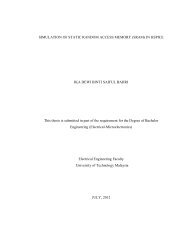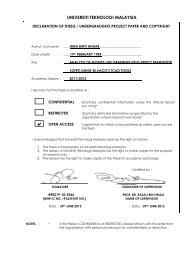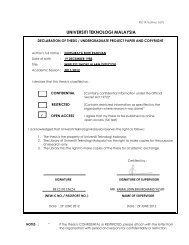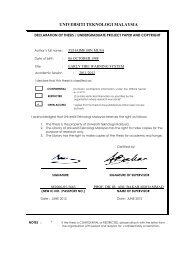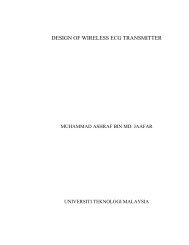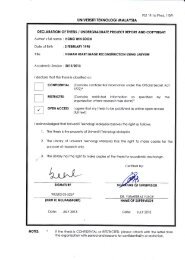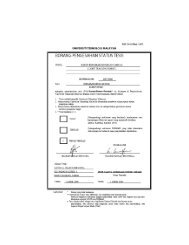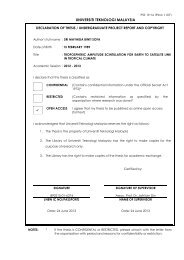automated traffic control scheme for ambulance dolwin ... - FKE - UTM
automated traffic control scheme for ambulance dolwin ... - FKE - UTM
automated traffic control scheme for ambulance dolwin ... - FKE - UTM
You also want an ePaper? Increase the reach of your titles
YUMPU automatically turns print PDFs into web optimized ePapers that Google loves.
AUTOMATED TRAFFIC CONTROL SCHEME FOR AMBULANCE<br />
DOLWIN KHO CHING CHING<br />
UNIVERSITI TEKNOLOGI MALAYSIA
PSZ 19: l6 (Pind. i 107)<br />
UNIVERSITI TEKNOLOGI iAAIAYSIA<br />
DECLARATTOH OF THESIS / UNDERGRADUATE PROJECT pApER AND<br />
COPYRIGHT<br />
Author's full nome<br />
Dote of birth<br />
Title<br />
: DOLWIII Kl{C} CHING CHING<br />
: 05,05 lqSq<br />
: Atl f{)MA'fllD TRAIrFl(l CONTROL SC}lLlMFi<br />
FOR AMBTJI"ANC[:<br />
Acodemic Session : 2Al2 I 2013<br />
ldeclore thot this thesis is clsssified os :<br />
1' I<br />
[]<br />
m<br />
CONFIDENTIAt {Contoins confidentiol in<strong>for</strong>motion under lhe Officiol<br />
SecretActlgT2).<br />
RESTRIcTED<br />
oPEN AccEss<br />
(Contoins restricted in<strong>for</strong>mation os specified by the<br />
orgonizotion where reseorch wos done)*<br />
I ogree thot my thesis to be published os online<br />
open occess {full textJ<br />
I ocknowledged thot Universfti Teknologi Moloysio reserves the righi os follows:<br />
Ihe thesis is the property of Universiti leknologi Moloysio.<br />
The Librory of Universiti Teknologi Moloysio hos the right to moke copies <strong>for</strong> the<br />
purpose of reseorch only.<br />
The Librory hos the right to moke copies of fhe thesis <strong>for</strong> ocodemic exchonge.<br />
.I<br />
SIGNATURE<br />
ATURT OF SUPERVISOR<br />
890505-l 3-6454 DR. LITU CIIENC SIONC<br />
{NEW rC NO, /PASSPORT NO"}<br />
NAME OF SUPERVISOR<br />
Dote: 9JUNEz}rc<br />
Dole: gJUNE 2A13<br />
NOTES : ' lf the thesis is CONFIDENTAL or RESTRICTED, pleose ottoch with the letter<br />
from the orgonizotion with period ond recsons <strong>for</strong> confidentiolity or<br />
resiriction.
AUTOMATED TRAFFIC CONTROL SCHEME FOR AMBULANCE<br />
DOLWIN KHO CHING CHING<br />
A thesis submitted in fulfillment of the<br />
requirements <strong>for</strong> the award of the degree of<br />
Bachelor of Engineering (Electrical – Mechatronics)<br />
Faculty of Electrical Engineering<br />
Universiti Teknologi Malaysia<br />
JUNE 2013
I declare that this thesis entitled "Automated Trffic Control Scheme <strong>for</strong> Ambulance"<br />
is the result of my own research except as cited in the references. The thesis has not<br />
been accepted <strong>for</strong> any degree and is not concurrently submitted in candidature of any<br />
other degree.<br />
Signature :<br />
Name :<br />
Date :<br />
DOLWIN KHO CHING CHING<br />
e. r.uNE 9.1L
iii<br />
Dedicated to my beloved family, <strong>for</strong> your love and supports.<br />
To my friends, <strong>for</strong> your wits, intelligence and guidance in life.
iv<br />
ACKNOWLEDGEMENT<br />
A project of this nature will not be completed without supports from different<br />
parties. The number of individuals who had made it possible are far exceeds those<br />
names grace the cover. I am very lucky in this respect to receive advice and<br />
assistance in many directions.<br />
A special mention of appreciations to my supervisor, Dr. Lim Cheng Siong<br />
<strong>for</strong> his advice and guidance throughtout the whole year <strong>for</strong> the completion of my<br />
Final Year Project.<br />
A special word of gratitudes to all my friends, who encouraged me to finish<br />
this project sucessly and not giving up.<br />
Last but not least, a thankful to my beloved parents and brother, who had<br />
always be there to support me and gave me inspirations in countless ways.
v<br />
ABSTRACT<br />
The design and implementation of client – server system and Global<br />
Positioning System to <strong>control</strong> road <strong>traffic</strong> network is presented. The server of the<br />
client – server system is programmed to receive the Global Positioning System<br />
in<strong>for</strong>mation from a moving vehicle via an independent device installed in that<br />
particular vehicle. The server will send the in<strong>for</strong>mation received to other nearby<br />
vehicles thereafter. The clients are multiple, are the moving vehicle and other nearby<br />
vehicles, programmed to keep the server updated of theirs Global Positioning System<br />
locations. A Graphical User Interface is built and used as a medium <strong>for</strong> users to start<br />
a connection with the client – server system and <strong>for</strong> the ease of location detection.<br />
The focus of this design is to have the road <strong>traffic</strong> network <strong>control</strong>led in order to give<br />
way to emergency vehicles such as <strong>ambulance</strong> to drive through. It is important <strong>for</strong><br />
emergency vehicles to have smooth <strong>traffic</strong> network while on duty in order to reach<br />
the emergency scenes as soon as possible and to improve emergency response time.
vi<br />
ABSTRAK<br />
Rekabentuk dan perlaksanaan sistem pelanggan – pelayan dan Sistem<br />
Kedudukan Sejagat untuk mengawal rangkaian lalulintas jalan raya dibentang.<br />
Bahagian pelayan daripada sistem pelanggan – pelayan tersebut diprogram untuk<br />
menerima maklumat kedudukan daripada sebuah kenderaan yang sedang bergerak<br />
melalui alat bebas yang dipasang dalam kenderaan berkenaan. Pelayan kemudiannya<br />
menghantar maklumat yang diterima tersebut kepada kenderaan lain yang<br />
berhampiran. Bahagian pelanggan adalah klien multi, iaitu kenderaan yang sedang<br />
bergerak dan kenderaan lain yang berhampiran, diprogram untuk memastikan<br />
pelayan mendapat maklumat lokasi terkini yang dikehendaki. Selain itu, sebuah<br />
Antara Muka Visual juga dibina dan digunakan sebagai medium interaksi untuk<br />
pengguna memulakan sambungan dengan sistem pelanggan – pelayan tersebut dan<br />
bagi memudahkan pegesanan lokasi. Fokus rekabentuk ini adalah untuk mengawal<br />
rangkaian lalulintas jalan raya bagi memberi keutamaan kepada kenderaan<br />
kecemasan seperti ambulans untuk memandu lalu. Adalah penting untuk kenderaan<br />
kecemasan mempunyai rangkaian lalulintas jalan raya yang lancar ketika beroperasi<br />
supaya sampai ke destinasi kecemasan secepat mungkin dan memperbaik masa<br />
tindak balas ketika kecemasan.
vii<br />
TABLE OF CONTENTS<br />
CHAPTER TITLE PAGE<br />
DECLARATION<br />
DEDICATION<br />
ACKNOWLEDGEMENT<br />
ABSTRACT<br />
ABSTRAK<br />
TABLE OF CONTENTS<br />
LIST OF TABLES<br />
LIST OF FIGURES<br />
LIST OF ABBREVIATIONS<br />
ii<br />
iii<br />
iv<br />
v<br />
vi<br />
vii<br />
x<br />
xi<br />
xiii<br />
1 INTRODUCTION 1<br />
1.1 Introduction 1<br />
1.2 Problem Statement 2<br />
1.3 Objectives of Research 4<br />
1.4 Scope of Study 4<br />
1.5 Research Methodology 5
viii<br />
1.6 Thesis Outline 8<br />
2 LITERATURE REVIEW 9<br />
2.1 Introduction 9<br />
2.2 Client – Server System 9<br />
2.3 Android OS and Java Language Programming 12<br />
2.4 Hearing Versus Visual Sense 14<br />
2.5 Literature Review of Related Work 17<br />
2.5.1 Ambulance Network Management 17<br />
2.5.2 Traffic Signal Timing Scheme <strong>for</strong> Priority Vehicles 19<br />
2.5.3 Vehicle Tracking System 21<br />
2.6 Summary of Literature Review 22<br />
2.7 Conclusion 23<br />
3 SYSTEM DESIGN 24<br />
3.1 Introduction 24<br />
3.2 Project Overview 24<br />
3.3 Project Flow 25<br />
3.4 Architecture Design 26<br />
3.5 Design Framework 27<br />
3.6 Application Development 28<br />
3.6.1 Android Apps Programming 30<br />
3.7 Expected Outcome 32
ix<br />
3.8 Conclusion 32<br />
4 RESULTS AND CONCLUSION 33<br />
4.1 Results 33<br />
4.2 Limitations and Problems Encountered 37<br />
5 CONCLUSION AND FUTURE WORKS 38<br />
5.1 Conclusion 38<br />
5.2 Recommendation <strong>for</strong> Future Works 39<br />
REFERENCES 40
x<br />
LIST OF TABLES<br />
TABLE NO. TITLE PAGE<br />
2.1 Summary of Reviewed Research/<br />
Projects<br />
22
xi<br />
LIST OF FIGURES<br />
FIGURE NO. TITLE PAGE<br />
1.1 Flowchart of the activities of the research starting from<br />
literature review until the achievement of the outcome<br />
of the research.<br />
7<br />
1.2 The thesis mapping based on chapters. 8<br />
2.1 A basic client – server system that communicates<br />
through either LAN or WAN.<br />
2.2 The whole supporting system architecture of Android.<br />
Android currently supports the applications,<br />
application framework, inclide libraries, the runtime<br />
and Linux kernel lizsted in the figure.<br />
2.3 An auditory system to process complex sound field<br />
into elements <strong>for</strong> sound sources interpretation.<br />
2.4 Architecture of the Ambulance Network Management<br />
System.<br />
11<br />
13<br />
16<br />
18<br />
2.5 Architecture of the Traffic Signal Timing Scheme. 20<br />
2.6 Architecture of the Vehicle Tracking System. 21<br />
3.1 Activities flow of project, starting from literature<br />
review to live test of ATCS.<br />
25<br />
3.2 Architecture design of ATCS. 26<br />
3.3 Design framework of the client – server system. 27
xii<br />
3.4 The software application development of ATCS.<br />
Whenever an <strong>ambulance</strong> starts operating, the<br />
application will enable location detection and get<br />
current position. Location data is sent to server. Server<br />
will tempt to notify nearby vehicles, if any, about the<br />
approaching <strong>ambulance</strong>.<br />
29<br />
3.5 GUI of the ATCS application. 31<br />
4.1 The GUI of the ATCS at the time <strong>ambulance</strong> starts 34<br />
operating.<br />
4.2 GPS location is detected when “Get Location” button<br />
pressed.<br />
4.3 The map view. Tab upon the “View Map”, the location<br />
and postion of the corresponding <strong>ambulance</strong> will be<br />
viewed on map.<br />
4.4 To send location data to other nearby vehicles. The<br />
above screen appears upon button “Send Location”<br />
pressed.<br />
4.5 Android 2 upon receiving location data from Android<br />
1. The location data is sent via a link. Android 2 users<br />
will tab on the link to view the location of the<br />
<strong>ambulance</strong>.<br />
34<br />
35<br />
35<br />
36<br />
4.6 The received data viewed on map. 36
xiii<br />
LIST OF ABBREVIATIONS<br />
EMS - Emergency Medical Services<br />
ATCS - Automated Traffic Control Scheme<br />
GPS - Global Positioning System<br />
GSM - Global System <strong>for</strong> Mobile Communications<br />
OS - Operating System<br />
IDE - Integrated Development Environment<br />
m - Metres<br />
<strong>UTM</strong> - University of Technology Malaysia<br />
LAN - Local Area Networks<br />
WAN - Wireless Area Networks<br />
SDK - Software Development Kits<br />
etc - Et cetera<br />
API - Application Programming Interfaces<br />
km /h - Kilometer per hour<br />
Hz - Hertz<br />
f o - Observed frequency<br />
f v - Actual frequency<br />
v - Velocity of sound<br />
v t - Velocity of moving object<br />
CH - Control Headquaters<br />
LCC - Local Control Centers<br />
C - Cycle time<br />
AUTCS - Advanced Urban Traffic Control System<br />
VDGS - Vehicle Dynamic Guidance System<br />
AVLS - Automatic Vehicle Location System<br />
GW - Gateway
xiv<br />
GUI - Graphical User Interface<br />
SMS - Short Message Service<br />
AVD - Android Virtual Devices
CHAPTER 1<br />
INTRODUCTION<br />
1.1 Introduction<br />
Emergency Medical Services (EMS) is a type of service that mainly to<br />
respond to emergency lifesaving cases. EMS provides out-of-hospital acute medical<br />
care and all means of medical transportations to the public or people with injuries<br />
and illnesses. Every life is precious. There<strong>for</strong>e, when it comes to situations affecting<br />
saving of life, every minute and second are crucial. To have the EMS to be<br />
delivered efficiently, the response time is of vital important. Any delay in the arrival<br />
of emergency transportations, which are the <strong>ambulance</strong>s, to the emergency scenes or<br />
to the hospitals might cause loss of life and expiration. Studies had shown the<br />
relationship between response time and mortality rate [1]–[4]. Emergency response<br />
time is defined as the time ranged starting from an emergency call received by EMS<br />
provider until the arrival of <strong>ambulance</strong> at the emergency scene [5]–[8]. A smooth<br />
road <strong>traffic</strong> network is recognized as one of many factors that may reduce time of<br />
arrival of <strong>ambulance</strong> at the emergency scenes [12]–[15]. There<strong>for</strong>e, once an<br />
<strong>ambulance</strong> is in operation state, road users must be aware of the arrival of preceding<br />
<strong>ambulance</strong> and be cooperated to make way <strong>for</strong> <strong>ambulance</strong> to drive through, so that<br />
<strong>ambulance</strong> is able to passage safely among many cars to the emergency scene<br />
within the standard response time.
2<br />
To smooth out road <strong>traffic</strong> network, I've come out with an idea, which is the<br />
Automated Traffic Control Scheme <strong>for</strong> Ambulance (ATCS). Basically, ATCS is an<br />
approaching emergency vehicle to cars communication that may create cooperate<br />
awareness among road users regarding the approaching <strong>ambulance</strong> behind them. It is<br />
a <strong>scheme</strong> or a strategy used to <strong>control</strong> road <strong>traffic</strong> network <strong>for</strong> dispatched <strong>ambulance</strong>.<br />
Through ATCS, road users will be notified earlier about the exact locations and<br />
directions of the dispatched <strong>ambulance</strong>, there<strong>for</strong>e allow proper reaction to be taken<br />
be<strong>for</strong>e <strong>ambulance</strong> reaches behind the drivers. This gives road users an early<br />
preparation to clear the road <strong>for</strong> the <strong>ambulance</strong>, there<strong>for</strong>e reducing <strong>ambulance</strong> on<br />
road queue time. The locations and directions data of the corresponding <strong>ambulance</strong><br />
are collected using Global Positioning System (GPS) and transmitted to server<br />
through Global System <strong>for</strong> Mobile Communications (GSM). These data will then<br />
sent to road users so that they are notified about the approaching <strong>ambulance</strong>, and<br />
then clear the road <strong>for</strong> <strong>ambulance</strong> to passage by.<br />
The aim of this research is to <strong>control</strong> road <strong>traffic</strong> network so that the<br />
operating <strong>ambulance</strong>s are able to passage smoothly to reach dispatched destinations<br />
within standard response time.<br />
1.2 Problem Statement<br />
Every life is precious. Every minute means difference between life and death.<br />
There<strong>for</strong>e, when it comes to situations affecting saving of life, every minute and<br />
second are crucial. Considering the importance of EMS is to save life, any situation<br />
that potentially caused delay in the arrival of <strong>ambulance</strong> to the emergency scenes or<br />
to the hospitals might cause loss of life as well as expiration. An <strong>ambulance</strong> need to<br />
response to an emergency within time ranged in seven to 14 minutes in urban areas,<br />
whereas in rural areas takes about 30 minutes [9]. However, the actual response time<br />
always take later than that. Why
3<br />
Traffic is number one obstacle [10]–[11]. More often <strong>ambulance</strong>s are not<br />
given the priority to drive through among many cars. With the increasing <strong>traffic</strong> on<br />
the roads, <strong>ambulance</strong>s have a tough task in reaching dispatched destinations on time.<br />
Giving way to any vehicles with flashing lights and blaring siren has being a very<br />
basic driving rule requirement in many countries. In Malaysia <strong>for</strong> example, under<br />
Road Traffic Act 1987 and Traffic Regulations 1958 has stated that one can be<br />
charged under Section 119 (2) <strong>for</strong> not giving way to <strong>ambulance</strong>s, police, customs, so<br />
<strong>for</strong>th. However, the problem with some drivers is that they are confused in which<br />
directions the <strong>ambulance</strong>s are coming, causing delay to give proper reactions even<br />
though they have heard the siren blaring. Clearly, blaring siren only tells road users<br />
the presence of <strong>ambulance</strong>s, but does not give any accurate in<strong>for</strong>mation to road users<br />
about the locations and directions of <strong>ambulance</strong>s precisely enough to allow proper<br />
reaction.<br />
In case of emergency, <strong>ambulance</strong>s need to drive fast and in safe and careful<br />
manners. There<strong>for</strong>e, it is stressful and very frustrating if any car just does not get out<br />
of the way. Research have done to solve the <strong>traffic</strong> problems, <strong>for</strong> example to enlarge<br />
the road network by building special links to passage the <strong>ambulance</strong>, as suggested by<br />
Qin and Khan [13]. Another solution is to build new <strong>traffic</strong> facilities. However, side<br />
problems arose due to the limitation of land and fund collections. Thus, an alternative<br />
in attention <strong>for</strong> solving is to <strong>control</strong> the road <strong>traffic</strong> network. Most of the research<br />
done were on <strong>traffic</strong> signal timing, that is to locate and to give priority to emergency<br />
vehicles to drive through at signalized intersection [13]–[18]. None of the research<br />
has done on providing in<strong>for</strong>mation and notifications regarding the locations and<br />
directions of preceding <strong>ambulance</strong>s to other road users.
4<br />
1.3 Objectives of Research<br />
The objectives in conducting this research work are defined as following:<br />
i. To develop a basic client – server system;<br />
ii. To implement the ATCS into the client – server system;<br />
iii. To live test the implemented ATCS.<br />
1.4 Scope of Study<br />
Basically, this research consists of three parts. The first part is the<br />
development of a basic client – server system. Second part is to develop the ATCS<br />
application and implement it into the client – server system. The last part is the live<br />
test of the ACTS.<br />
For the client – server system, two sets of smart phones running Android<br />
operating system (OS) are used as the clients, while a laptop running Windows 7 OS<br />
is used as the server. Java programming language is used to develop the coding and<br />
compiled using Netbeans Integrated Development Environment (IDE) version 7.3 <strong>for</strong><br />
both clients and server. Collected data are transferred through GSM and will not be<br />
saved in database. The server is programmed to listen and accept or reject clients’<br />
requests, and keep listening to the clients. The clients, one of them are programmed<br />
to request connection from server and send data to it, and keep updating the server<br />
with the latest in<strong>for</strong>mation. The other client is programmed to receive data only, and<br />
keep up-to-date the in<strong>for</strong>mation.<br />
For the second part of this research, the application, that is the ATCS, is<br />
developed and implemented into the client – server system. One of the smart phones<br />
is programmed to enable locating its own location and send the location data to the<br />
server periodically. The server on the other hand is programmed to collect the
5<br />
corresponding location data and send the data to another smart phone that is in the<br />
range of 600 meters (m) ahead from the previous smart phone. Clients and server are<br />
made sure to have the updated location in<strong>for</strong>mation from time to time.<br />
Last one is to live test of the implemented ATCS. For the experimental setup<br />
to live test, two cars are used and the ATCS is tested in University of Technology<br />
Malaysia (<strong>UTM</strong>) campus. Both smart phones are placed inside cars with each car has<br />
one smart phone. One of the cars is used to represent the <strong>ambulance</strong> and the other<br />
one representing general vehicles. A laptop that acts as the server is placed at Kolej<br />
Tun Razak’s office and monitored. During the live test, both of the cars are driven<br />
around suitable areas in <strong>UTM</strong> campus. The location data of the car that representing<br />
the <strong>ambulance</strong> is tested to be able to send to server and is received by the other car<br />
that is in the distance range of 600 m ahead.<br />
1.5 Research Methodology<br />
Ambulances have to respond to an emergency as fast as possible. Firstly, the<br />
problems that potentially caused delay or interruption in the operations of<br />
<strong>ambulance</strong>s are identified. It is found that <strong>traffic</strong> is number one obstacle. There<strong>for</strong>e,<br />
to passage an <strong>ambulance</strong> among other vehicles to reach its dispatched destination on<br />
time, a <strong>scheme</strong> is developed with the aim to <strong>control</strong> the road <strong>traffic</strong> network that may<br />
give priority to <strong>ambulance</strong> to passage by. There are two parts to build up the <strong>scheme</strong>;<br />
the development of a basic client – server system and the implementation of ATCS<br />
application into the client – server system.<br />
A basic client – server system is developed to collect the location data of the<br />
<strong>ambulance</strong> and send the corresponding data to other general vehicles. Implemented<br />
ATCS application is programmed to locate one client and tells the server where the<br />
client is.
6<br />
To determine whether the <strong>scheme</strong> has succeeded to work, a live test<br />
per<strong>for</strong>med. The research methodology is summarized in Figure 1.1. The flow chart<br />
shows the process to identify problem intend to this project until the development of<br />
<strong>traffic</strong> <strong>control</strong>ling <strong>scheme</strong> to improve <strong>ambulance</strong>s operations.
7<br />
No<br />
Start<br />
Literature Review<br />
Basic client-server<br />
system development<br />
Server side<br />
application<br />
development<br />
Client side application<br />
development<br />
Is live test of<br />
<strong>scheme</strong> working<br />
Scheme successfully<br />
work<br />
Yes<br />
Problem<br />
To develop a <strong>scheme</strong> that is able to <strong>control</strong> road<br />
<strong>traffic</strong> and passage <strong>ambulance</strong> to targeted<br />
emergency scene within response time<br />
Objective 1<br />
Development of a basic client – server system<br />
Scope<br />
Socket connection between client – server is<br />
established<br />
Objective 2<br />
Implementation of the <strong>traffic</strong> <strong>control</strong> <strong>scheme</strong> into<br />
client – server system<br />
Scope<br />
Location data of client to send to server<br />
continuously<br />
Client nearby should able to receive data from<br />
server<br />
Objective 3<br />
Live test of <strong>automated</strong> <strong>traffic</strong> <strong>control</strong> <strong>scheme</strong><br />
Scope<br />
To test whether the location data is successfully<br />
send over the system<br />
Outcome<br />
Development of working Automated Traffic<br />
Control System<br />
End<br />
Figure 1.1:<br />
Flow chart of the activities of the research starting from literature<br />
review until the achievement of the outcome of the research.
8<br />
1.6 Thesis Outline<br />
The rest of this thesis is sorted in the following manner. Chapter 2 describes<br />
the theories of client – server application, Android programming and the hearing<br />
versus visual sensing abilities. Related projects are reviewed and summarized in<br />
Chapter 2 as well.<br />
The system design of ATCS is discussed in Chapter 3. The whole ATCS<br />
operation is software <strong>control</strong>lable. How the client – server system works and the<br />
function of ATCS will be explained in details.<br />
The obtained results are shown in Chapter 4. The analysis and problems<br />
encountered upon the process of developing the ATCS will be reviewed in this<br />
chapter.<br />
The project is concluded in Chapter 5 with some recommendations <strong>for</strong> future<br />
works. The flow of chapters is mapped as shown in Figure 1.2 below.<br />
Scope of Research<br />
Literature<br />
Reviews<br />
Output<br />
Future Works<br />
Chapter 2 Chapter 3<br />
Chapter 4 Chapter 5<br />
Figure 1.2:<br />
The thesis mapping based on chapters.
CHAPTER 2<br />
LITERATURE REVIEW<br />
2.1 Introduction<br />
The basic concept of the client – server system and other tools used in this<br />
research will be described in this chapter. The idea of developing ATCS to aid human<br />
hearing sense on <strong>ambulance</strong> siren will be explained. Some other supportive ideas to<br />
this research and similar projects will be reviewed in this chapter as well.<br />
2.2 Client – Server System<br />
Client – server system is a computing system that consists of two independent<br />
logical parts, that is the server and the client, where both are specialized <strong>for</strong> different<br />
tasks. In<strong>for</strong>mation processing has becoming so much easier since the inception of<br />
client – server computing in the mid-1980s [19]. The server functioned to provide<br />
services to which clients requested them. The server and the client may run on the<br />
same or different computing machines or hardware of the same or different OS and<br />
coded or programmed using either the same or different programming language<br />
[19]–[20].
10<br />
The client – server system may only communicate and transmit data through<br />
communication mechanisms such as local area networks (LAN) or wireless area<br />
networks (WAN). A single server may be connected to a client or several clients, or<br />
works with other servers as well.<br />
The application logic or client – server programming are the medium that<br />
determines how the data supposed to be transmitted and distributed between the<br />
client and the server. Usually the main method will be implemented in the server<br />
program to per<strong>for</strong>m works such as listening to the port, establishing connections with<br />
clients, and reading from and writing to the socket. Server will keep track of the<br />
clients and services the clients’ queries. On the other hand, the client initiates to<br />
communicate with server, per<strong>for</strong>m request or command to server, and computes<br />
results and process the results to user readable. Figure 2.1 shows a basic client –<br />
server functions.<br />
Both the application logic at the client and server side can be written using<br />
the similar or different programming languages, depending on the computing<br />
machines’ OS. Basically, the client and the server program of any OS will begin with<br />
Socket class programming. Socket class defines how a connection between client and<br />
server is established and how the data are send to and from a pre-defined port. Few<br />
lines below show a portion of Socket of the server side in Java programming<br />
language.<br />
ServerSocket serverSocket = null;<br />
try {<br />
serversocket = new ServerSocket (1234);<br />
}<br />
.<br />
.<br />
.<br />
Socket clientSocket = null;<br />
try {<br />
clientSocket = serverSocket.accept();<br />
}
11<br />
After a connection is established, client and server will communicate as defined in<br />
the rest of the programming class. In the interest of a good housekeeping, both server<br />
and client need to close all the input and output streams, client socket as well as the<br />
server socket defined at the end of the program.<br />
Figure 2.1:<br />
or WAN.<br />
A basic client – server system that communicates through either LAN
12<br />
2.3 Android OS and Java Language Programming<br />
Android, currently the world's most popular mobile plat<strong>for</strong>m is a software<br />
stack that has made available to most touchscreen mobile devices such as smart<br />
phones and tablet computers. It is not a single piece of hardware, but a complete,<br />
end-to-end software plat<strong>for</strong>m that includes operating system, middleware, libraries<br />
and also key applications, adapted to work on infinite numbers of hardware<br />
configurations [21]–[23]. The operating system is based on Linux kernel and<br />
supports Java programming interface. The whole supporting system architecture of<br />
Android is shown in Figure 2.2.<br />
Android is an open source Linux <strong>for</strong> developers to build best-in-class<br />
applications experiences. The source codes are accessible and freely available to the<br />
public, under the license of Apache version 2.0 and GNU General Public License<br />
version 2. The Open Handset Alliance and Google also involved in developing<br />
changes to Linux kernel and source code privately, however compiled source codes<br />
are available to the public as well. Android's openness and permissive licensing<br />
features allow most of applications to be developed, modified and to be tested not<br />
only by software developers but also individuals who are interested. A lot of software<br />
development kits now available to support Android application writing and<br />
development such as Eclipse, Netbeans IDE, Java Software Development Kits<br />
(SDK), etc. Another interesting feature of Android is supportive of third party<br />
software and firmware development.<br />
To help programmers and developers to start developing their own<br />
applications efficiently, Android has developed its own Android SDK and IDE<br />
plugins, available <strong>for</strong> all and downloadable from the official websites of Android<br />
Developers [23]. The SDK is a complete package of all currently available Android<br />
Application Programming Interfaces (APIs), sources, libraries and other build tools<br />
that are useful in developing Android applications.
13<br />
Figure 2.2: The whole supporting system architecture of Android. Android<br />
currently supports the applications, application framework, include libraries, the<br />
runtime and Linux kernel listed in the figure.
14<br />
2.4 Hearing versus Visual Sense<br />
For an <strong>ambulance</strong> that is in operation state, consider the <strong>ambulance</strong> will speed<br />
up to 90 kilometer per hour (km/h), and the frequency of the blaring siren at 700<br />
Hertz (Hz). By comparing the value of siren’s frequency to the frequency range that a<br />
normal human can adapt, that is in the range of 20 Hz to 20, 000 Hz, 700 Hz is<br />
considered low frequency of sound.<br />
To determine the actual frequencies emitted by the <strong>ambulance</strong> siren when the<br />
<strong>ambulance</strong> is approaching, passing, and moving away from an observer, the equation;<br />
f o = f v /(v – v t ) (2.1)<br />
is used, where f o is observed frequency, f v is the actual frequency emitted, while v<br />
and v t are velocity of sound and velocity of moving object respectively;<br />
i. As the <strong>ambulance</strong> is approaching the observer;<br />
f v = 700 Hz<br />
v = 343 m/s (speed of sound in air at normal temperature)<br />
v t = 90 km/h<br />
∴ f o = 700 x 343 /(343 - 25) = 755.031 Hz<br />
ii. At the moment the <strong>ambulance</strong> passing by the observer;<br />
f v = 700 Hz<br />
v = 343 m/s<br />
v t = 0 km/h<br />
∴ f o = f v = 700 Hz<br />
iii. As the <strong>ambulance</strong> moving away from the observer;<br />
f v = 700 Hz<br />
v = 343 m/s<br />
v t = -90 km/h<br />
∴ f o = 652.446 Hz
15<br />
There<strong>for</strong>e, as the <strong>ambulance</strong> approaching, passing by and moving away from an<br />
observer, the <strong>ambulance</strong> siren will emit frequencies at 755 Hz, 700 Hz, and 652 Hz<br />
respectively. It is shown that the siren frequency is slightly higher when the<br />
<strong>ambulance</strong> is approaching nearby drivers. 755 Hz, this value is still considered as<br />
low frequency and not able to travel far plus easily affected by surrounding noise <strong>for</strong><br />
human auditory adaptations [25]. Surrounding noise would be noise produces by<br />
other vehicles or passengers in the drivers’ vehicles.<br />
The crucial task per<strong>for</strong>med by any auditory system is sound source<br />
determination. Sound does not reach a listener independently, rather are combined<br />
altogether sound sources into one complex sound field [26]. The auditory system will<br />
then do processing on the neural representation of the complex sound field into<br />
elements that allow the listeners to interpret the sound sources. Figure 2.3 shows the<br />
concept of auditory system.<br />
According to Yost [26], all sound sources are potential signals or noises. The<br />
knowledge of sound sources comes from our own perception of auditory images.<br />
Auditory images are the bases <strong>for</strong> hearing and each auditory image indicates a<br />
possible sound source. As we are surrounded by more than one sound source,<br />
there<strong>for</strong>e the input to our auditory system is the complex sound field that summed<br />
the vibratory patterns generated by each of the sound sources. However, not every<br />
sound source in the complex sound field produces auditory image. The vibration<br />
pattern of certain sound sources may be too weak to be perceived relative to that<br />
produced by other sound sources. From the above calculations, it is observed that the<br />
siren sound only becomes louder when nearly approaching observer with a value of<br />
755 Hz. There<strong>for</strong>e there might be difficulties <strong>for</strong> listener to interpret at an early stage<br />
to predict an incoming <strong>ambulance</strong> plus the effect of surround noise. Considering the<br />
individual variability on listening ef<strong>for</strong>ts, a research found that people often faced<br />
problems with hearing especially when there is a low signal-to-noise ratio [27].<br />
Whenever a person is affected by the noise from surrounding, his or her per<strong>for</strong>mance<br />
to interpret sound source will be affected.
16<br />
In real-life, drivers faced difficulties in determining the exact direction of an<br />
approaching <strong>ambulance</strong>. As communications are more effectives through non-verbal,<br />
that is more visual and less audio [28], there<strong>for</strong>e rather than depending only to the<br />
siren sound of <strong>ambulance</strong> alone [29], an earlier notification to let the drivers to view<br />
the actual location of the preceding <strong>ambulance</strong> through a visual aid might help. In<br />
this case, drivers will get an early view of the position and directions of the<br />
corresponding <strong>ambulance</strong> and once give proper reactions.<br />
Figure 2.3:<br />
sound sources interpretation.<br />
An auditory system to process complex sound field into elements <strong>for</strong>
17<br />
2.5 Literature Review of Related Work<br />
A lot of researches and projects have been done by universities and<br />
organizations regarding to improve the current operations of <strong>ambulance</strong>. Some did<br />
the researches on signalized <strong>traffic</strong> light, vehicles tracking and so on. The following<br />
are some of the researches and projects collected from different sources.<br />
2.5.1 Ambulance Network Management<br />
This is a project done by researchers of University of Zaragoza [16]. The aim<br />
of this project is to know the current location as well as the duty state of all the<br />
<strong>ambulance</strong>s in the database at all time, and then have the <strong>control</strong> center to plan an<br />
ideal route <strong>for</strong> the <strong>ambulance</strong> in operation to reach the emergency scene. Both client<br />
– server system and GPS system are used in this project. To provide a fast and<br />
efficient response, GPS-based fleet <strong>control</strong> system was implemented to locate the<br />
location of each <strong>ambulance</strong> periodically. As all the <strong>ambulance</strong>s are equipped with<br />
radio equipment integrated with GPS cards, there<strong>for</strong>e the location in<strong>for</strong>mation are<br />
able to send to the <strong>control</strong> center. The <strong>control</strong> center also monitors the <strong>traffic</strong><br />
conditions be<strong>for</strong>e route planning. Figure 2.4 shows the <strong>ambulance</strong> network<br />
management system architecture.<br />
As can be seen from the figure, there is a Control Headquarter (CH) that<br />
functions to locate the <strong>ambulance</strong> and to seek its duty states, monitoring <strong>traffic</strong><br />
conditions as well as do route planning. There is several Local Control Centers (LCC)<br />
functioned to analyze and track <strong>ambulance</strong> only. Data are then sent over to CH <strong>for</strong><br />
decision making.
18<br />
The disadvantage of this project is the existence of LCCs. LCCs does not<br />
involve in any decision making. As the LCCs only track the location of <strong>ambulance</strong><br />
and sending the in<strong>for</strong>mation to CH, there<strong>for</strong>e LCC might increase the overall<br />
response time due to extra time used in sending in<strong>for</strong>mation and waiting <strong>for</strong><br />
decisions from CH. Another downside is that although CH monitors <strong>traffic</strong><br />
conditions, however it does not manipulate the <strong>traffic</strong> network to passage the<br />
<strong>ambulance</strong>s to reach targeted scene. The overall <strong>ambulance</strong>s operations do not<br />
improve much.<br />
Figure 2.4:<br />
Architecture of the Ambulance Network Management System.
19<br />
2.5.2 Traffic Signal Timing Scheme <strong>for</strong> Priority Vehicles<br />
This is another project done that aims to manipulate the <strong>traffic</strong> signal timing,<br />
so that priority vehicles such as <strong>ambulance</strong> will always meet green signal light<br />
whenever they had reached signalized intersections, there<strong>for</strong>e avoid queuing at the<br />
intersections [17]. This project also involved the use of client – server system and<br />
GPS system. Priority vehicles are installed with GPS system so that positions and<br />
speed can be obtained. Then, the time taken to reach a <strong>traffic</strong> light is generated by the<br />
vehicle itself. A cycle time, C is the defined standard time <strong>for</strong> a <strong>traffic</strong> light to turn<br />
green. Request will only be sent to <strong>control</strong> center if time calculated is less than C.<br />
Decisions are made by the <strong>control</strong> center regarding the time to turn the <strong>traffic</strong> light to<br />
green.<br />
Figure 2.5 shows the architecture of this <strong>scheme</strong>. The subsystems that<br />
involved in this <strong>scheme</strong> are Advanced Urban Traffic Control System (AUTCS),<br />
Vehicles Dynamic Guidance System (VDGS), and Automatic Vehicle Location<br />
System (AVLS). AUTCS is functioned <strong>for</strong> decision making whether to turn the<br />
<strong>traffic</strong> lights green or not and the time to do so. VDGS basically used to process and<br />
broadcasts in<strong>for</strong>mation regarding <strong>traffic</strong> flow and travelling time. AVLS is used to<br />
generate position data of the vehicles.<br />
The downside of this project is that the <strong>control</strong> center will only be notified<br />
when the priority vehicles is within the cycle time, C be<strong>for</strong>e reaching any signalized<br />
junctions. Control center is not getting any updates of the current location of the<br />
vehicles. By emulating this project on the installation of GPS system in vehicles but<br />
sending the current position to the <strong>control</strong> center, there<strong>for</strong>e accurate distance away<br />
from other general vehicles can be measured.
20<br />
Figure 2.5:<br />
Architecture of the Traffic Signal Timing Scheme.
21<br />
2.5.3 Vehicle Tracking System<br />
The focus of this project is to track the desired vehicles with low cost but<br />
effective to substitute the existing high cost vehicle tracking system that used<br />
embedded GPS [18]. The project proposed to use wireless sensor devices that are<br />
installed in the vehicles and are addressed by the vehicles’ registration number which<br />
are made unique.<br />
There are mainly three components implemented in this tracking system;<br />
wireless sensor devices, gateway (GW) node, and central server. Wireless sensor<br />
devices are installed in vehicles as mentioned be<strong>for</strong>e. They are functioned to send<br />
relevant data to GW node. GW node is responsible to respond to query from server<br />
and data processing, while central server propagates queries to GW node and<br />
receives data from GW node. To keep track of the vehicles, GW nodes are installed<br />
at a regular interval distance. Figure 2.6 shows the architecture of this system.<br />
Figure 2.6:<br />
Architecture of the Vehicle Tracking System.
22<br />
Although this tracking system is low cost without the implementation of GPS<br />
system, however there exist a lot of disadvantages, as admitted by the researchers<br />
themselves. The existence of GW nodes is actually a waste, as these nodes are unable<br />
to track vehicles with higher speed and higher number of vehicles that come and go<br />
within the interval distance. Accuracy would be the main problem. As there would be<br />
a number of thousands of GW nodes to be installed over a region, there<strong>for</strong>e huge<br />
bandwidth is consumed over a network <strong>for</strong> in<strong>for</strong>mation updates, which means a<br />
waste of money and resources. On the other hand, by implementing GPS into vehicle,<br />
an accurate position and other in<strong>for</strong>mation can be obtained through reliable GSM.<br />
2.6 Summary of Literature Review<br />
Table 2.1 summarizes the project reviewed and their important criteria that can be<br />
advanced or emulated in this research.<br />
Research/<br />
Table 2.1:<br />
Criteria<br />
Summary of Reviewed Research/Projects<br />
Research/Project Emulate<br />
Project<br />
Ambulance<br />
Network<br />
Management<br />
Traffic<br />
Signal<br />
Timing<br />
Scheme<br />
i. Client – server and GPS<br />
Used to collect current<br />
location and duty states of<br />
<strong>ambulance</strong><br />
Monitoring <strong>traffic</strong><br />
conditions<br />
i. GPS (installed in<br />
vehicles)<br />
To locate vehicles<br />
position away from a<br />
<strong>traffic</strong> light<br />
i. Client – server and<br />
GPS<br />
To collect data of<br />
location of <strong>ambulance</strong><br />
continuously<br />
i. GPS<br />
<br />
To locate location of<br />
vehicles and send the<br />
in<strong>for</strong>mation to server
23<br />
ii.<br />
Client – server<br />
ii.<br />
Client – server<br />
<br />
Server receive requests<br />
from vehicles and decides<br />
whether or not to turn<br />
<strong>traffic</strong> light to signal<br />
green<br />
<br />
Server is updated with<br />
vehicles’ current<br />
location and send<br />
in<strong>for</strong>mation to other<br />
general vehicles instead<br />
of <strong>traffic</strong> lights<br />
Vehicle<br />
Tracking<br />
System<br />
i. Wireless sensor devices<br />
ii.<br />
<br />
Send relevant data to GW<br />
node<br />
GW node<br />
Process data from<br />
wireless sensor devices<br />
and response to central<br />
server<br />
i. GPS to replace wireless<br />
sensor devices as GPS<br />
provides more accuracy<br />
in<strong>for</strong>mation<br />
ii. Eliminates GW node<br />
due to accuracy<br />
problems<br />
iii.<br />
<br />
Central server<br />
Propagates queries to GW<br />
nodes and receives<br />
in<strong>for</strong>mation from GW<br />
nodes<br />
2.7 Conclusion<br />
From the project review above, the design <strong>for</strong> my project will take considerations as<br />
follow:<br />
i. Client – server to collect and receive current location data from <strong>ambulance</strong><br />
units;<br />
ii. GPS will be installed in <strong>ambulance</strong> and also general vehicles, known as<br />
<strong>ambulance</strong> units and vehicle units respectively;<br />
iii. Vehicle units nearby <strong>ambulance</strong> units received in<strong>for</strong>mation of the <strong>ambulance</strong>.
CHAPTER 3<br />
SYSTEM DESIGN<br />
3.1 Introduction<br />
This chapter will briefly describe the flow of the project. Also, the methods<br />
used to develop ATCS and the design of the ATCS will be specifically described in<br />
this chapter. All the software used in this project and design of architecture will be<br />
shown.<br />
3.2 Project Overview<br />
Basically, the ATCS must fulfill the following specifications:<br />
i. Ambulance unit must be able to locate its own current location and send the<br />
coressponding data to server;<br />
ii. Location data is received by server;<br />
iii. Ambulance unit must be able to continuously update server with the current<br />
location;<br />
iv. Location data is received by vehicle unit.
25<br />
3.3 Project Flow<br />
The sequence of activities of the project is shown in Figure 3.1. The project is<br />
began by doing research on related or similar project. Various articles, journals, and<br />
thesis that are relevant to be referred are found through various sources. Some<br />
projects are taken as references and are emulated into this project. After all relevant<br />
in<strong>for</strong>mation are gathered, a basic architecture is designed first to get a firm picture of<br />
overall project, followed by design of system framework. Then a basic client – server<br />
system is developed, followed by implementation of ATCS. Lastly, a live test is<br />
per<strong>for</strong>med to determined that whether the objectives are achieved or failed.<br />
Literature Review<br />
Architecture Design<br />
Basic Client – server Development<br />
Implementation of ATCS into Client – server<br />
System<br />
Live Test of ATCS<br />
Figure 3.1:<br />
ATCS.<br />
Activities flow of project, starting from literature review to live test of
26<br />
3.4 Achitecture Design<br />
The following figure shows the architecture design of ATCS. As describe<br />
earlier, two sets of smart phones running Android OS are used as the clients and are<br />
placed inside two cars. Referred to Figure 3.2, Android 1 is used to represent an<br />
<strong>ambulance</strong>, and its current GPS location will be sent to a laptop that acts as server.<br />
Data are send continuously through GSM. While Android 2, which represents<br />
general vehicle will be receiving the location data of Android 1 if it is in the radial<br />
distance range of 600 m ahead from Android 1.<br />
3G/GSM<br />
Server<br />
(Laptop)<br />
INTERNET<br />
3G/GSM<br />
3G/GSM<br />
Ambulance<br />
(Android 1)<br />
Distance: 600 meter<br />
General Vehicle<br />
(Android 2)<br />
Figure 3.2:<br />
Architecture design of ATCS.
27<br />
3.5 Design Framework<br />
Design framework as shown in Figure 3.3 will further explains on how the<br />
ATCS application works with the client –server system. Basically in every client –<br />
server system, a connection have to be establised first be<strong>for</strong>e any client can<br />
communicates with server. Client is the party that request connection from server,<br />
while server will decide to accept or reject the connection. After a connection is<br />
established, server will keep listening to each of client’s request and serve whenever<br />
the request is a valid one.<br />
During ATCS runtime, a connection will be established when the <strong>ambulance</strong><br />
request to send its location data to the server. After connection established,<br />
<strong>ambulance</strong> will continuously update the server with the latest GPS position. Server<br />
will keep track of the <strong>ambulance</strong> location and then open connection with general<br />
vehicles that are located in radial distance range of 600 m. Server will send<br />
in<strong>for</strong>mation to the general vehicles, notified the position of <strong>ambulance</strong>.<br />
Client<br />
Server<br />
Client<br />
Open connection<br />
Trying to open coonection<br />
Accept connection<br />
Listening to client’s request<br />
Listening to client’s request<br />
Request server<br />
Accept request<br />
Send GPS location data<br />
Send GPS location data<br />
Receive GPS location data<br />
Figure 3.3:<br />
Design framework of the client – server system.
28<br />
3.6 Application Development<br />
The software and firmware used in this project will be described here. Since<br />
the whole ATCS operation is software <strong>control</strong>lable, thus the application can be<br />
reprogrammed many times without any major changes on the hardware used.<br />
For the hardware parts, embedded GPS module and GSM module of smart<br />
phones are used. The software application design includes programming the smart<br />
phones to toggle location detection and data transmission over the client – server<br />
system, and also the Graphical User Interface (GUI) <strong>for</strong> client – server interaction.<br />
The software application is programmed using Netbeans IDE version 7.3 using Java<br />
programming language. Figure 3.4 shows the flowchart in developing the software<br />
application.
29<br />
Start<br />
Ambulance to receive its<br />
location through GPS<br />
Server keep updated of<br />
<strong>ambulance</strong>’s location<br />
GPS location send to Server<br />
Is there any vehicles<br />
within 600m from<br />
<strong>ambulance</strong><br />
No<br />
Keep Track of other vehicles<br />
Yes<br />
Notify the vehicles about the<br />
location and direction of<br />
<strong>ambulance</strong><br />
End<br />
Figure 3.4: The software application development of ATCS. Whenever an<br />
<strong>ambulance</strong> starts operating, the application will enable location detection and get<br />
current position. Location data is sent to server. Server will tempt to notify nearby<br />
vehicles, if any, about the approaching <strong>ambulance</strong>.
30<br />
3.6.1 Android Apps Programing<br />
Android, currently the world’s most popular mobile plat<strong>for</strong>m is a software<br />
stack that has made available to most touchscreen mobile devices such as smart<br />
phones and tablet computers. It is an open source application development, and most<br />
of the source codes to toggle Android services are available at Android Developers<br />
website [23].<br />
In this project, I am trying to toggle the LocationManager services and intent<br />
Short Message Service (SMS) sending. LocationManager is a class that provides<br />
access to the system location services. These services will allow applications to<br />
obtain updates of a device’s geographical locations. To use the services to locate<br />
owns location, certain permissions need to be coded into the manifest, like<br />
ACCESS_COURSE_LOCATION or ACCESS_FINE_LOCATION permissions. In<br />
the case to obtain location provided by GPS satellite, ACCESS_FINE_LOCATION<br />
permission is needed unless otherwise noted. ACCESS_COURSE_LOCATION is<br />
used when one intended to obtained location provided by network providers. The<br />
location data obtained using GPS satellite is far more accurate than that obtained<br />
from network providers.<br />
The obtained data will be viewed on map. Then, MapActivity will need to be<br />
coded. MapActivity is a map component in an application. The location data that had<br />
sent to other general vehicles will be viewed in Google Map <strong>for</strong>mat. There<strong>for</strong>e,<br />
MapActivity is acquired to load the underlying map system, or it will return null if<br />
the map is not available.<br />
GUI is a medium <strong>for</strong> interaction between users and the server. The GUI of<br />
ATCS is customized under the Android layout resources file. I’ve set tab layout and<br />
apps menu button <strong>for</strong> user conveniences. Figure 3.5 shows the GUI <strong>for</strong> ATCS.
31<br />
Tab Layout<br />
Menu Button<br />
Figure 3.5:<br />
GUI of the ATCS application.<br />
“View Status” tab is to view the current position obtained when “Get Location”<br />
button pressed. “Lat:” and “Long:” are the latitude and longitude position<br />
respectively. “Alt:” is the altitude position, while “Speed:” is the speed of the current<br />
moving <strong>ambulance</strong>. “Time:” shows the response time of <strong>ambulance</strong> to an emergency.<br />
Latitude and longitude data is send to server whenever “Send Location” button is<br />
pressed.<br />
To ease the programmers and developers to test run applications, Android has<br />
developed Android Virtual Devices (AVD) and its own SDK and IDE plugins to<br />
support import of APIs packages and libraries <strong>for</strong> different compilers used. The AVD<br />
allows virtual devices of different plat<strong>for</strong>ms to be created or emulators to be run on<br />
computers or laptop to ease any changes to be made to the software applications. For<br />
this project, I am using Android 2.3 and 4.1 target plat<strong>for</strong>ms.
32<br />
3.7 Expected Outcome<br />
It is expected that the client – server system developed is able to<br />
communicate and data are successfully being transferred over the system. There are<br />
two sides of clients, and it is expected that one of the client is able to receive<br />
in<strong>for</strong>mation regarding another client through server. It is also to be expected that<br />
<strong>scheme</strong> developed is able to <strong>control</strong> the road <strong>traffic</strong> network and indirectly improving<br />
the response time of <strong>ambulance</strong>s’ operations.<br />
3.8 Conclusion<br />
This chapter has discusses the Automated Traffic Control Scheme <strong>for</strong><br />
Ambulance in terms of its design and application development. To ensure that this<br />
project can be functioned as intended, all the hardware and software design have to<br />
be carefully designed, developed, implemented, and tested follows the parent<br />
objectives of the project. At the end of the day, the application designed must enable<br />
data to be transmitted over the client – server system developed.
CHAPTER 4<br />
RESULTS AND DISCUSSION<br />
The results, analysis, and problems encountered throughout the whole process<br />
of developing the ATCS will be reviewed in this chapter. The effectiveness of ATCS<br />
to improve <strong>ambulance</strong> operation as a whole will be evaluated upon completion of the<br />
project. Whether the project has met the objectives and limitations will also be<br />
discussed.<br />
4.1 Results<br />
The ATCS consists of two Android smart phones, one to be programmed to<br />
locate owns GPS location, another to receive the corresponding data. Figures 4.1 to<br />
4.4 show the flow of the ATCS that worked, starting from location detected until data<br />
is sent out of the <strong>ambulance</strong> unit, the Android 1, while Figures 4.4 and 4.5 show the<br />
flow whenever data is received by Android 2 sent from Android 1.
34<br />
Figure 4.1: The GUI of the ATCS at the time <strong>ambulance</strong> starts operating.<br />
Figure 4.2: GPS location is detected when the ‘Get Location’ button pressed.
35<br />
Figure 4.3: The map view. Tab upon the “View Map”, the location and position of<br />
the corresponding <strong>ambulance</strong> will be viewed on map.<br />
Figure 4.4: To send location data to other nearby vehicles. The above screen<br />
appears upon button “Send Location” pressed.
36<br />
Figure 4.5: Android 2 upon receiving location data from Android 1. The location<br />
data is sent via a link. Android 2 users will tab on the link to view the location of the<br />
<strong>ambulance</strong>.<br />
Figure 4.6: The received data viewed on map.
37<br />
4.2 Limitations and Problems Encountered<br />
below;<br />
Some problems encountered during the completing of this project are listed<br />
<br />
The connections between clients and the server failed. The clients are unable<br />
to reach the server upon request <strong>for</strong> connection;<br />
<br />
The GPS location is provided by GPS satellite, there<strong>for</strong>e ATCS is unable to<br />
be used indoor. Otherwise, have to used location provided by network<br />
providers which are costly;<br />
<br />
The Google Map on the <strong>ambulance</strong> unit is unable to be viewed. There might<br />
be problems in the Google APIs key or metadata assignment;<br />
<br />
At the moment, ATCS is sending location data via SMS because to buy the<br />
real GPS navigation system is costly as two sets sre needed.
CHAPTER 5<br />
CONCLUSION AND FUTURE WORKS<br />
This chapter confers the conclusion of the research on Automated Traffic<br />
Control Scheme <strong>for</strong> Ambulance and a recommends future works to improve the<br />
quality of the <strong>traffic</strong> <strong>control</strong> <strong>scheme</strong>.<br />
5.1 Conclusion<br />
<br />
<br />
Upon completion of this project, the following objectives have met:<br />
To implement the ATCS into the client – server system;<br />
Live test of the implemented ATCS.<br />
Although there have been a lot of researches done with the objectives to<br />
improve <strong>ambulance</strong> operating system, this is the first project of its kind to have the<br />
<strong>ambulance</strong> communicates with nearby vehicles, in<strong>for</strong>ming the nearby vehicles the<br />
approaching <strong>ambulance</strong>. I believe the usage of ATCS can give positive impacts and<br />
future research to improve current <strong>ambulance</strong> operating system and create awareness<br />
among road users to clear the road and give priority to emergency vehicles to passage<br />
by.
39<br />
5.2 Recommendation <strong>for</strong> Future Works<br />
There are lots of rooms <strong>for</strong> improvements on this project. Some of the<br />
recommendations to be taken into account are as follow:<br />
Implements the ATCS into GPS navigation system;<br />
Instead of receiving notifications through SMS, pop-up notifications on the<br />
navigation system can be used that automatically tells road users the location<br />
and directions of the <strong>ambulance</strong>;<br />
Increase the accuracy of the geographical position obtained from GPS<br />
satellite;<br />
Make ATCS to be able to <strong>control</strong> <strong>traffic</strong> at signalized junctions as well.
REFERENCES<br />
[1] Sánchez-Mangas, R., García-Ferrrer, A., Juan, A. and Arroyo, A. M. The<br />
Probability of Death in Road Accident. How Important is a Quick Medical<br />
Response Accident Analysis & Prevention, vol. 42, no. 4. 1048–1056; 2010<br />
[2] Gonzalez, R. P., Cummings, G. R., Phelan, H. A., Mulekar, M. S. and<br />
Rodning, C. B. Does Increased Emergency Medical Services Prehospital<br />
Time Affect Patient Mortality in Rural Motor Vehicle Crashes A Statewide<br />
Analysis. The American Journal of Surgery, 2009. 197(1): 30–34.<br />
[3] Vukmir, R. B. Survival From Prehospital CAardiac Arrest is Critically<br />
Dependent Upon Response Time. Resuscitation, vol. 69, no. 2. 229–234;<br />
2006<br />
[4] Part 12: From Science to Survival: Strengthening the Chain of Survival in<br />
Every Community. Resuscitation, vol. 46, no. 1–3. 417–430; 2000<br />
[5] Castrén, M., Karlsten, R., Lippert, F., Christensen, E. F., Bovim, E., Kvam,<br />
A. M., Robertson-Steel, I., Overton, J., Kraft, T., Engerstrom, L. and<br />
Garcia-Castrill Riego, L. Recommended Guidelines <strong>for</strong> Reporting on<br />
Emergency Medical Dispatch When Conducting Research in Emergency<br />
Medicine: The Utstein Style. Resuscitation, vol. 79, no. 2. 193–197; 2008<br />
[6] Pons, P. T. and Markovchick, V. J. Eight Minutes or Less: Does the<br />
Ambulance Response Time Guideline Impact Trauma Patient Outcome<br />
The Journal of Emergency Medicine, 2002. 23(1): 43–48.<br />
[7] Marsden, A. K. Getting the Right Ambulance to the Right Patient at the<br />
Right Time. Accident and Emergency Nursing, vol. 3, no. 4. 177–183; 1995
41<br />
[8] Repede, J. F. and Bernardo, J. J. Developing and Validating a Decision<br />
Support System <strong>for</strong> Locating Emergency Medical Vehicles in Louisville,<br />
Kentucky. European Journal of Operational Research, 1994. 75(3): 567–<br />
581.<br />
[9] Lim, C. S., Mamat, R. and Braunl, T. Impact of Ambulance Dispatch<br />
Policies on Per<strong>for</strong>mance of Emergency Medical Services. Intelligent<br />
Transportation System, 2011. 12(2): 624–632.<br />
[10] Weiss, S. J., Ellis, R., Ernst, A. A., Land, R. F. and Garza, A. A Comparison<br />
of Rural and Urban Ambulance Crashes. The American Journal of<br />
Emergency Medicine, 2001. 19(1): 52–56.<br />
[11] Drucker, C., Gerberich, S. G., Manser, M. P., Alexander, B. H., Church, T.<br />
R., Ryan, A. D. and Becic, E. Factors Associated with Civilian Drivers<br />
Involved in Crashes with Emergency Vehicles. Accident Analysis &<br />
Prevention, vol. 55. 116–123; 2013<br />
[12] Alsalloum, O. I. and Rand, G. K. Extensions to Emergency Vehicle<br />
Location Models. Computers and Operations Research, vol. 33, no. 9.<br />
2725–2743; 2006<br />
[13] Qin, X. and Khan, A. M. Control Strategies of Traffic Signal Timing<br />
Transition <strong>for</strong> emergency Vehicles Preemption. Transportation Research<br />
Part C: Emerging Technologies, 2012. 25(1): 1–17.<br />
[14] Hussin, R., Ismail, R. C., Murrali, E. and Kamarudin, A. Wireless Traffic<br />
Light Controller <strong>for</strong> Emergency Vehicle through XBee and Basic Stamp<br />
Micro<strong>control</strong>ler. Procedia Engineering, vol. 41. 636–642; 2012<br />
[15] Athavan, K., Balasubramaniam, G., Jagadeshwaran, S. and Dinesh, N.<br />
Automatic Ambulance Rescue System. Advanced Computing &<br />
Communication Technologies (ACCT). January 7–8, 2012. 190–195.
42<br />
[16] Zarazaga-Soria, F. J., Álvarez, P. J., Bañares, J. A., Nogueras, J., Valiño, J.<br />
and Muro-Medrano, P. R. Examples of Vehicle Location Systems Using<br />
CORBA-Based Distributed Real-Time GPS Data and Services. Computers,<br />
Environment and Urban Systems, vol. 25, no. 3. 293–305; 2001<br />
[17] Yang, Z. and Guan, D. Study on the Schemes of Traffic Signal Timing <strong>for</strong><br />
Priority Vehicles Based on Navigation System. Vehicle Electronics<br />
Conference. 2001. IVEC. 2001. 249–254.<br />
[18] Aravind, K. G., Chakravarty, T., Candra, M. G. and Balamuralidhar, P. On<br />
the Architecture of Vehicle Tracking System Using Wireless Sensor<br />
Devices. Ultra Modern Telecommunications & Workshops, 2009,<br />
International Conference. October 12–14, 2009. 1–5.<br />
[19] Ruffer, S. M., Yen, D. and Lee, S. Client/server Computing Technology: A<br />
Framework <strong>for</strong> Feasibility Analysis and Implementation. International<br />
Journal of In<strong>for</strong>mation Management, 1995. 15(2): 135–150.<br />
[20] Roussev, B. and Wu, J. Distributed Computing Using Java: A Comparison<br />
of Two Server Designs. Journal of Systems Architecture, 2006. 52(7): 432–<br />
440.<br />
[21] Hoog, A. Android Forensics. Elsevier Inc. 2011<br />
[22] Vidas, T., Zhang, C. and Christin, N. Toward a General Collection<br />
Methodology <strong>for</strong> Android Devices. Digital Investigation: The International<br />
Journal of Digital Forensics & Incident Response, 2011. 8(1): S14–S24.<br />
[23] Developers. Android Developers. Retrieved on September, 2012, from<br />
http://developer.android.com/<br />
[24] Grantham, D. W. Chapter 9 - Spatial Hearing and Related Phenomena. In:<br />
Brian C. J. Moore. ed. Hearing. San Diego: Academic Press Inc. 297–345;<br />
1995<br />
[25] Yost, W. A. Auditory Image Perception and Analysis: The Basis <strong>for</strong><br />
Hearing. Hearing Research, 1991. 56(1–2): 8–18.
43<br />
[26] Picou, E. M. The Effect of Individual Variability on Listening Ef<strong>for</strong>t in<br />
Unaided and Aided Conditions. Ph. D. Thesis. University of Vanderbilt;<br />
2011<br />
[27] Perrin, T., May, H., Anderson, E. and Brooker, D. Chapter 7 – Non – Verbal<br />
Communication: The Currency of Wellbeing. In: Wellbeing in Dementia<br />
(Second Edition). Edinburgh, Churchill Livingstone. 97–115; 2008<br />
[28] Lorenzo, R. D. and Eilers, M. Lights and Siren: A Review of Emergency<br />
Vehicle Warning Systems. Annals of Emergency Medicine, 1991. 20(1):<br />
1331–1335.



